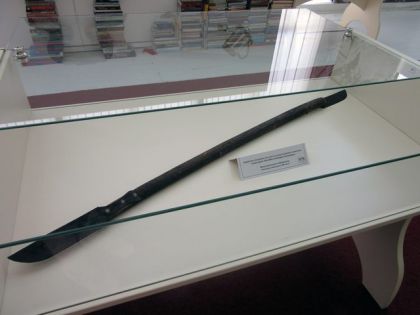More than 11,000 children from 219 Kozara small towns and villages were killed. Average age of 11,194 killed boys and girls was 6.5

By Ana Bencun
The Ustasha knife designed for mass slaughter of Serb children in the Second World War incites extremely strong emotions in all visitors of the exhibition “Anatomy of Oblivion” displayed at the National and University Library (NUB) of Republika Srpska.
“Only when you take the knife in your hand and ask yourself: What is this? How does this work? you realise the dread of the events that the exhibition talks about,” one of the exhibition authors, Vanja Smulja, has told Srna.
The knife was found at Patrija at the foothills of Kozara, where not only during the offensive in the summer of 1942, but also throughout the war, horrific killings of civilians were committed.
According to Smulja, among the custom made weapons used by Ustashas, knives hold a special place because they were used to commit mass murders without any noise.
“The most recognised specified-purpose knife that Ustashas used in the camps of the Independent State of Croatia (NDH) is the ‘srbosjek’ (Serb cutter) – a knife with a sort of a glove, manufactured on the basis of a Nazi project by the German factory Gebrüder Gräfrath from Solingen-Widdert,” explains Smulja.
She notes that the exhibit is a physical proof that there was a system that manufactured “tools” for mass killings in order to make the “job of its troops more efficient and easier.”
“It was a system that wiped out innocent people, guilty only for their Serb, Roma or Jewish identity, in most monstrous ways.
“It was a system that punished children as the future potential enemies of the Croatian state with the death penalty, never allowing them to grow up, let alone become danger to national security,” said Smulja.
Furthermore, the exhibit holds significance also as a symbol of the suffering of the Serb people, and also as a part of history and a proof that materialises the crime itself.
“This exhibit is the only tangible, three-dimensional part of the exhibition and certainly takes the central place in the display. Its importance for the exhibition is extraordinary because it materialises the terror shown in the photographs and documents,” notes Smulja.
The knife, which is the ownership of the Museum of the Revolution at Mrakovica and a part of its permanent display, provokes a reaction in visitors that is hard to describe.
“A normal human being can simply not understand or accept the fact that there actually existed something like a custom made knife for mass killings of children,” says Smulja.
She is certain that this exhibit opens a different perspective for observing the WWII events in these parts.
According to the data supplied by the Association of Child Detainees, Their Ancestors and Supporters Jastrebarsko 1942, more than 11,000 children from 219 Kozara small towns and villages were killed.
The youngest ones were still in diapers and cradles, while the eldest were 14.
Early death came to infants mainly. 1,195 were only a few days or a few months old. The average age of 11,194 killed boys and girls was 6.5?!
Smulja says that the idea to organise the exhibition was created indirectly, thanks to academician Srboljub Zivanovic, who bequeathed his private library to the National and University Library of Republika Srpska.
It was suggested during talks about the legacy that the NUB create an exhibition to mark the Sixth International Conference on Jasenovac.
Authors of the exhibition open until May 18 are NUB librarians Vanja Smulja, Spomenka Kuzmanovic and Ljubica Milekic.
Везане виjести:
ЈАСЕНОВАЧКА „АНАТОМИЈА ЗАБОРАВА“ У ЛОНДОНУ – Jadovno …
Проф. др Србољуб Живановић: Ко jе био фра Срећко Перић …
СПОМЕН НА СТРАДАЛУ ДЈЕЦУ У ЛОГОРУ ЈАСТРЕБАРСКО …

